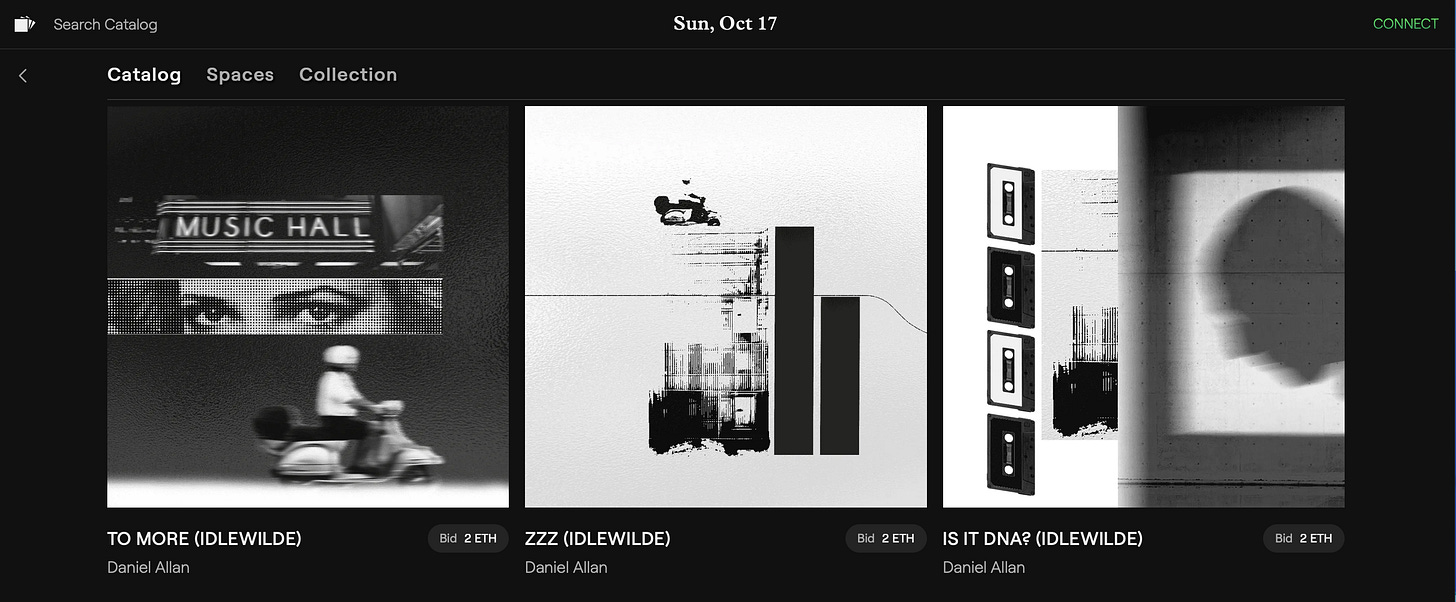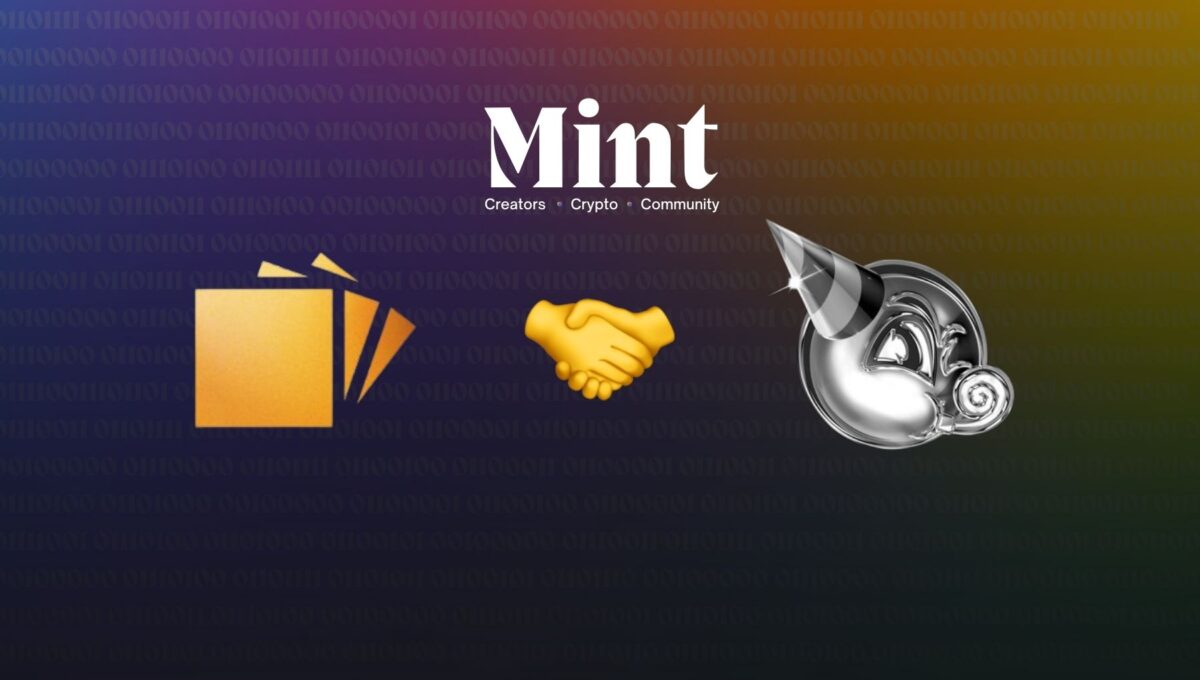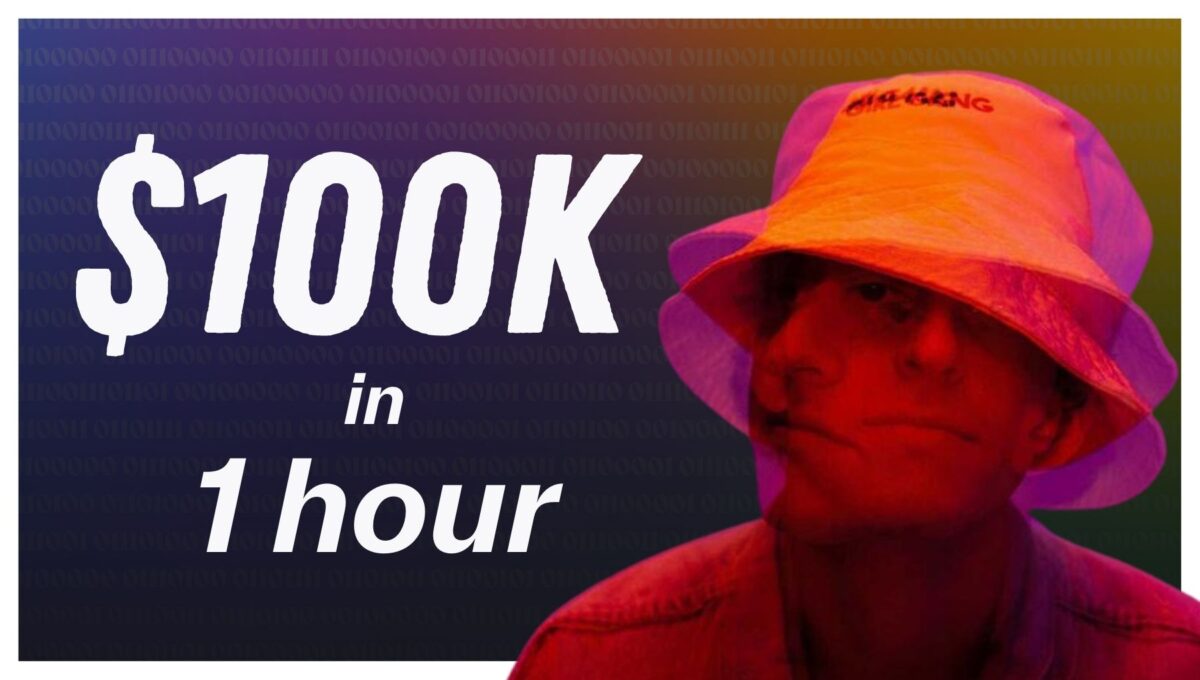In this post, we’re diving into the creative and crypto-curious mind of Daniel Allan.
After his successful crowdfunding campaign on Mirror for his EP Overstimulated, Daniel came up with a new experiment. After spending 36 hours of creative boot camp in Idaho with his friends, he dropped five songs on Catalog Works and set up a Party Bid for every single. I wrote about his first experiment a couple of weeks ago, and I wanted to talk with him to learn his motivation and creative process behind this new project.
Aleyna: Can you tell me the story behind IDLEWILDE?
Daniel: The first project I did was drifter series. I went to a random location on the map, took photographs with a disposable camera, made artwork from it, and I made a song in the location, and that was the NFT. The second project was I helped to bring some friends on Catalog by making a song with them and putting it on Catalog.
After doing that, I wanted to scale it up a little bit. 2 things that I value a lot are collaborating with others and traveling — pointing to a random place on the map, and making music there. What I wanted to do here is to combine these two, both going to a random place and working with friends. This seemed like the best of both worlds. So it was me, my creative director Lisa, and White Lucas, another artist in the web3 space. We decided to go to Idaho in the mountains. We went there and made this project together called IDLEWILDE.
We have a 5 track EP, we did it in 36 hours. 36 hours of art essentially. What I wanted to experiment with is Party Bid. I have experience with crowdfunding because of my project on Mirror, and I wanted to experiment with what happens if I make a Party Bid for each song. The barrier of entry is a bit difficult sometimes because you need to have $300-500, and for a lot of people, that’s a lot of money. So I wanted to bring the barrier of entry down a little bit.
Aleyna: Wow, that’s amazing. I agree – 1 ETH might be nothing in crypto for some people, but IRL that’s a lot of money. What made you decide to go with Catalog Works since there are others like Audius?
Daniel: I like both Catalog and Audius, but for Catalog specifically, a lot of collectors know I am there. Catalog for me is, I treated as SoundCloud in 2014. Essentially I have an idea, and I want to share my demos with no judgment really. In Audius, they have really cool full songs.
Aleyna: Perhaps a little like Spotify and SoundCloud difference.
Daniel: Yeah, I would say that’s a really good way to put it. They would kill me for saying that but for the sake of this analogy.
Aleyna: I want to go back a little bit and ask how you got started in web3.
Daniel: Around March, I played a show in a friend’s backyard, and I put the show into 2 parts. The first show was music that was already out. The second show was unreleased music. The objective there was to showcase my music to a bunch of A&Rs and industry people there. A&Rs and industry people said music is great; let’s find a home for it. One of the people who came was Cooper Turley, who ended up being my project manager for the Mirror crowdfund. He said, “If you’re ever looking for a way to put this music up, let’s see if there is a way for us to work together.” I wasn’t really sure then what web3 was, to be fair.
The next month I went through all the various label opportunities, and I wasn’t in love with any of them. So I reached out to Cooper and asked how I can get involved. He said, “okay you need to start making NFTs.” In my mind, NFT was this crazy visual rendering that 3d animators do. He said, “no, no, my buddy Jeremy is working on this thing called Catalog.” That changed things for me because it made it very accessible. I just needed a still artwork and the music. All I needed to do was figure out how to put an artwork together. For the next month or so after I minted and sold a couple of works on Catalog, I said I’m ready to go. He said, “no you need to spend a couple of months initiating yourself in the community.” And the rest is history.
Aleyna: That’s a really cool onboarding story. Especially I think the music industry in web3 is very early and there are a lot of opportunities. It’s also an industry where the technological developments like streaming have made it difficult for artists to make a living.
Daniel: You hear it every day we’re early, but we’re especially early in the music space. Visual NFTs have seen their moment in the mainstream; this is the potential of how the space looks like. I don’t think outside of LAU in the music space that something like that got as popular. Lau is the biggest project that found a home in web3. I think the most interesting with my case study is that I had 200 followers on Twitter, so it shows how accessible this is. I think in the next 12 months there will be a lot of web3 music artists.
Aleyna: What did you learn and took away from Overstimulated?
Daniel: In full disclosure, OVERSTIM is my number one priority. That was a life-changing moment for me because a lot of people were interested in it. And that kinda changed my perspective on the music industry in general. So while OVERSTIM is my number one priority, I’m always down to experiment. One piece of advice I got early on was too many people in crypto space spend a lot of time thinking but not a lot of time doing so I’m in the mindset that I’d rather throw shit on the wall and see what sticks.
So with this project, that’s just me doing it. I wanted to see how it would look scaled up. Musically and artistically, I wanted to put up this medium-scale project that isn’t as big as OVERSTIM, but we curated and put it together. My takeaway from OVERSTIM is nothing happens overnight. A lot of people looked and said, “wow you sold out in 12 hours”, and multiple people tried doing it afterward. But what a lot of people didn’t see is, for 3 months, I really didn’t put up any music because I was probably spending 10 hours a day on discord saying hi to people individually and being a newbie and asking very newbie questions. That isn’t a sexy thing you know. If you want to do something, you need to pay due diligence and introduce yourself to the community.
Aleyna: How about IDLEWILDE?
Daniel: I think my takeaway from IDLEWILDE, I mean, it was a couple of days ago, so I need time to process it, but in general, my takeaway is you can scale art to whatever degree you want to as long as you have a community behind you.
But I also think that going to a super nice Airbnb and making music with friends was super liberating for me, to be able to have the financial freedom to be able to do that off the back of OVERSTIM and being a web3 artist with my Catalog sales. It was very empowering. If anything, IDLEWILDE has reinforced what I felt about web3 and the music industry in general. Generally, it’s a really good model to live off the back of your patrons. You don’t have to have a million fans; one thousand fans are plenty as long as they’re devoted.

Aleyna: Your experiments will definitely push forward what is possible, which is very exciting to watch. You might be Dom Hoffman for music in web3.
Daniel: In this space, if you’re not pushing boundaries and what is possible, then you’re NGMI. A lot of people after my crowdfund tried to replicate it — it didn’t necessarily do as well. When I do the next crowdfund, which won’t be for a while, it has to be drastically different. 2 weeks in real life is one day in crypto. If you’re not doing something new and radically different, it’s not necessarily a winning formula, and the only way to find that is to experiment.
Aleyna: I totally agree with what you’re saying. When I dove into NFTs this year, I thought I wanted to make my own collectibles project for the sake of understanding the process and seeing it first hand, and learning it. From the outside, it seems so easy, but when you actually get down to it, it’s way more complicated.
Daniel: Yeah, there is also something to be said about having skin in the game. I feel like if you put your money in and lose money, you’ll remember it. You’ll learn a lot about it. When I was getting started, I made a point that I wanted to do it myself.
Aleyna: I’m really excited to see what you come up with next and your new and exciting experiments.
This background story gave me even more excitement about IDLEWILDE and what Daniel will come up with next. Stay tuned for his future projects as he will continue to experiment with new ideas, and push boundaries in music industry with web3 tools. Check out his songs on Catalog here, and find the Party Bid links on his thread here.


